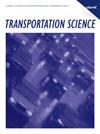Heatmap Design for Probabilistic Driver Repositioning in Crowdsourced Delivery
IF 4.8
2区 工程技术
Q1 OPERATIONS RESEARCH & MANAGEMENT SCIENCE
引用次数: 0
Abstract
This paper proposes the use of heatmaps as a control lever to manage the probabilistic repositioning of independent drivers in crowdsourced delivery platforms. The platform aims to maximize order fulfillment by dynamically matching drivers and orders and selecting heatmaps that trigger the probabilistic flow of unmatched drivers to balance driver supply and delivery requests across the service region. We develop a Markov decision process (MDP) model to sequentially select matching and heatmap decisions in which the repositioning behavior of drivers is captured by a multinomial logit discrete choice model. Because of the curse of dimensionality and the endogenous uncertainty of driver repositioning, the MDP model is solved using a rolling-horizon stochastic lookahead policy. This policy decomposes matching and heatmap decisions into two optimization problems: a two-stage stochastic programming upper bounding problem for matching decisions and a mixed-integer programming problem for heatmap decisions. We also propose a simple policy for efficiently solving large-scale problems. An extensive computational study on instances derived from the Chicago ride-hailing data set is conducted. Computational experiments demonstrate the value of heatmaps in improving order fulfillment beyond the level achieved by matching alone (up to 25%) and identify conditions that affect the benefit of using heatmaps to guide driver repositioning.Funding: The authors gratefully acknowledge the support of the Natural Sciences and Engineering Research Council of Canada through Discovery Grants [Grants RGPIN-2024-04881, RGPIN-2020-04498, and RGPIN-2019-06207] awarded to the first, second, and third authors, respectively.Supplemental Material: The online appendix is available at https://doi.org/10.1287/trsc.2022.0418 .为众包配送中的概率驱动程序重新定位设计热图
本文提出使用热图作为控制杠杆,管理众包配送平台中独立司机的概率性重新定位。该平台旨在通过动态匹配司机和订单以及选择热图来触发未匹配司机的概率流动,以平衡整个服务区域的司机供应和配送请求,从而最大限度地完成订单。我们开发了一个马尔可夫决策过程(MDP)模型,用于依次选择匹配和热图决策,其中司机的重新定位行为由多项式对数离散选择模型来捕捉。由于维度诅咒和司机重新定位的内生不确定性,MDP 模型采用滚动式随机前瞻策略进行求解。该策略将匹配和热图决策分解为两个优化问题:匹配决策的两阶段随机编程上界问题和热图决策的混合整数编程问题。我们还提出了高效解决大规模问题的简单策略。我们对来自芝加哥打车数据集的实例进行了广泛的计算研究。计算实验证明了热力图在提高订单完成率方面的价值,超过了仅通过匹配实现的水平(高达 25%),并确定了影响使用热力图指导司机重新定位的益处的条件:作者衷心感谢加拿大自然科学与工程研究理事会通过分别授予第一、第二和第三作者的发现基金[Grants RGPIN-2024-04881、RGPIN-2020-04498 和 RGPIN-2019-06207]提供的支持:在线附录见 https://doi.org/10.1287/trsc.2022.0418 。
本文章由计算机程序翻译,如有差异,请以英文原文为准。
求助全文
约1分钟内获得全文
求助全文
来源期刊

Transportation Science
工程技术-运筹学与管理科学
CiteScore
8.30
自引率
10.90%
发文量
111
审稿时长
12 months
期刊介绍:
Transportation Science, published quarterly by INFORMS, is the flagship journal of the Transportation Science and Logistics Society of INFORMS. As the foremost scientific journal in the cross-disciplinary operational research field of transportation analysis, Transportation Science publishes high-quality original contributions and surveys on phenomena associated with all modes of transportation, present and prospective, including mainly all levels of planning, design, economic, operational, and social aspects. Transportation Science focuses primarily on fundamental theories, coupled with observational and experimental studies of transportation and logistics phenomena and processes, mathematical models, advanced methodologies and novel applications in transportation and logistics systems analysis, planning and design. The journal covers a broad range of topics that include vehicular and human traffic flow theories, models and their application to traffic operations and management, strategic, tactical, and operational planning of transportation and logistics systems; performance analysis methods and system design and optimization; theories and analysis methods for network and spatial activity interaction, equilibrium and dynamics; economics of transportation system supply and evaluation; methodologies for analysis of transportation user behavior and the demand for transportation and logistics services.
Transportation Science is international in scope, with editors from nations around the globe. The editorial board reflects the diverse interdisciplinary interests of the transportation science and logistics community, with members that hold primary affiliations in engineering (civil, industrial, and aeronautical), physics, economics, applied mathematics, and business.
 求助内容:
求助内容: 应助结果提醒方式:
应助结果提醒方式:


